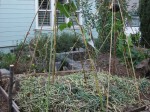
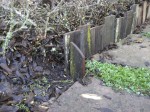
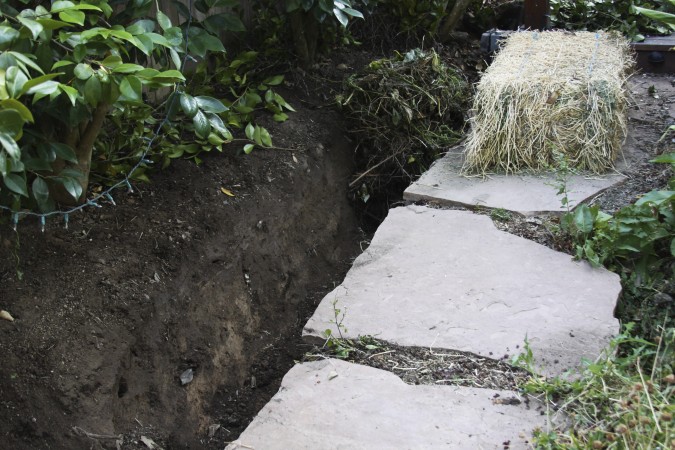
071509 Leaf Trench Highway. Soil has been harvested from the trench, between the slate walk path and the planting bed. The trench will be prepped for more soil making, starting with a base of straw from the awaiting bale. Since this picture, lots of organics have been composted onto and into the trench. Those organics include: tree prunings, wheat straw, alfalfa straw, oak leaves, carbon harvest (for example, pumpkin vines), twigs and stout tree limbs, wood chips, and horse manure. Beautiful, rich, high quality tilth soil has been harvested several times from the trench.
1. Constructed a low retaining wall to increase the soil volume of a planting bed, Leaf Trench Highway. Leaf Treanch Highway got its name back in 2007 when we were installing irrigation supply to our garden’s back corner. The water supply was trenched along a walk path, buried about three (3) feet and encased in 3″ perforated plastic drainpipe. The depth and casement were to allow “mistakes” in the garden — a shovel could graze the drainpipe and might not break through and bust the water supply. Lots of digging since then, and no busted trench pipe, yet. The trench was called a “highway” because, when filled with leaves, or other organics, it’s a corridor for critters to move about the garden.
So, there we were, in 2007, with a sizeable 3-foot deep trench running along the property line’s planting bed. We decided to use the trench to make soil; we would use the trench to turn compostable material into planting soil.
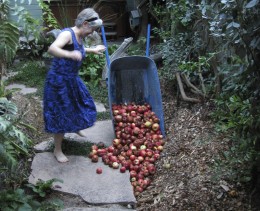
"Opps! Did I spill that?" No, Anita, Leaf Trench Highway is getting a rotten apple harvest -- Sebastopol's finest for our dear soil-making critters.
About every six months, the trench is dug up for a soil harvest. That harvested soil is then used to amend the soil in the gardens. And yes, sometimes waiting the six months or so is difficult. But having fresh, new, teeming-with-microbe, alive! soil on hand when we do harvest is all that much more a treat after the wait.
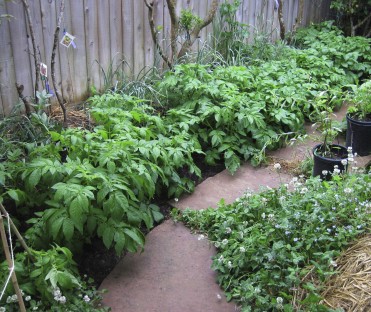
Potato (broad-leaved), garlic (along fence), red and white clover grow in Leaf Trench Highway in the summer of 2010. The red and white clover serve as both insectary and nitrogen-fixing plants.
This time around, in 2012, I want to grow a crop above the composting trench. I want us to produce a garlic and vegetable crop WHILE the trench is composting. I have also found that new crop love a good compost under it. BUT, the compost can not be too hot or the new crop will burn. For this planting, there is a good base of wood chips, green manure, oak leaves, and a recent magnolia tree pruning. Especially with the magnolia twigs and limbs, those bulky organics will supply microbes, miosture, and nutrients to the growing crop. Also, as the crop plants grow, their roots will travel the moist, nutrient-rich paths along the decaying wood. Great mulch for the coming dryer months. Throughout the spring, we will harvest salad from the composting trench. By July, the garlic will be ready to be dug up — harvest garlic, harvet soil. Garlic for the kitchen, soil for the garden.
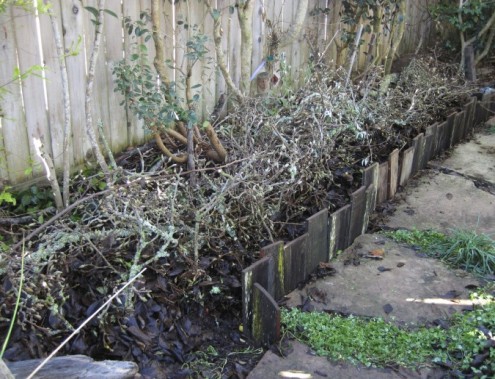
Low retaining wall built to increase the soil capacity of Leaf Trench Highway's planting bed. Old redwood fence boards were cut in two-foot lengths and pounded into the gap between the planting bed and the vertical slate border. Using a wood block between the fence board and the sledgehammer kept the fence boards from splitting.
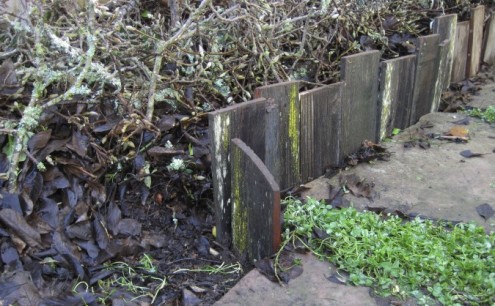
20120108-LTH-retaining-wall, close-up. Note the beautiful mosses and lichens on the old fence board. Not only is this FREE!!! redwood fence board functional (it will last many years in the soil), it is also beautiful. Moist soil from the planting bed was rubbed into the board cuts to instantly age those fresh-cut surfaces -- we are talking art here! I am interested to see if that soil smear will promote moss growth on the top edges of the boards. Stay tuned.
2. Manure run. Collected both hot (fresh) and cold (old) horse manure from my secret source (nothing personal). The hot manure was laid down at the bottom of the fence boards to create a little heat for the wintering crops. The cold manure, which is pretty much a sandy loam soil because it has broken down for so long, was thrown on top of the bed. That cold manure was thrown into and on top of the magnolia tree prunings, enough of it to plant the crops in.
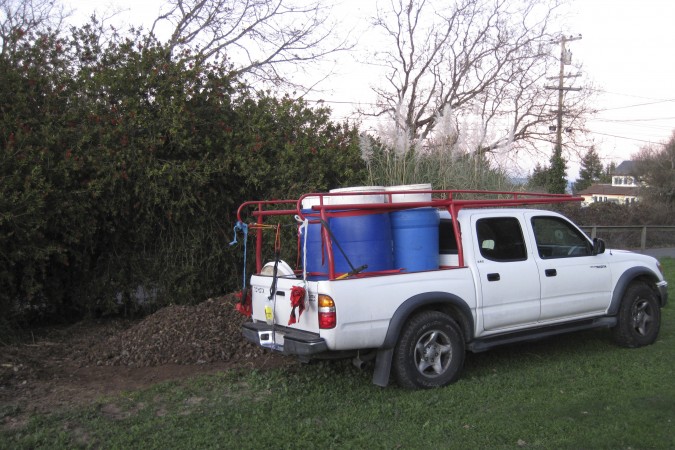
Collecting horse manure from a neighbor's pile. The bins/barrels help keep the job cleaner and easier. Using the barrels, my truck does not have to be washed afterwards and the manure can sit in the bins until ready for use. Sure is nice to load it once (into the barrels) but not have to clear it out of my truck's bed the same day. Note the looseness of the fresh (hot) pile at the rear of the truck. That pile was moved twice -- once to get it out of the way so the buried old (cold) manure could be harvested, then again to fill up the hole that cold manure harvest left. Perhaps in 6 months, that filled in hole will be cold manure soil itself. Just another example of our wondrous revolving World at work.
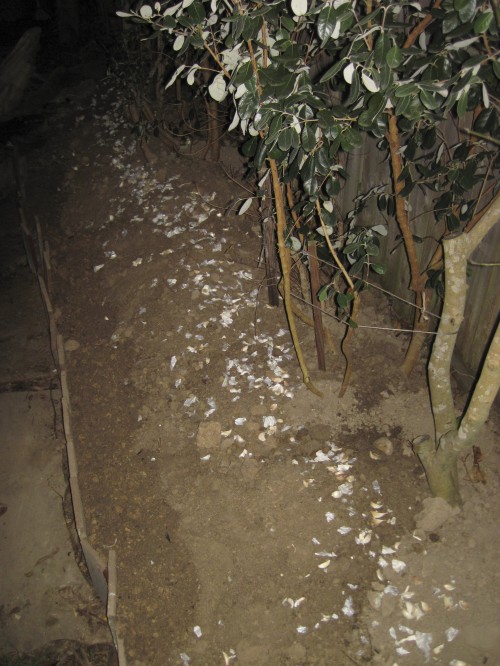
It's late, but the garlic is in. Come tomorrow, I will throw a thin mulch of rice straw over the veggie seeds and garlic starts. Note how the low retaining wall of recycled (reused) fence board allowed enough soil to be added to the bed to cover most of the magnolia prunings. Will be exciting to see what crops actually do rise out of the straw mulch and to see how well they thrive in this compost, soil-making bed. Oh, did I tell you -- it's an experiment. 🙂
1. Leaf Trench Highway is a major no-toll pathway in our garden. True, there is often construction along this roadway, but the improvements are always worth it. This year’s road upgrades include last year’s woodchip pile from Santa Rosa’s waterways cleanup (oak and willow), oak leaves from the neighborhood, our ridiculous Jack-in-the-Beanstalk pumpkin patch green manure, the magnolia tree’s prunings, hot manure, and cold manure soil. Microbes party down! All insects and amphibians welcomed. Just add water, as the soon-to-come rains will do, and the entire length of Leaf Trench Highway will be a mess of healthy fungi, vegetables, flowers, microbes, crawly critters, and birds. And that’s just at ground level. The length of the trench, along the fence, is a fedge — food hedge, a permaculture term. That hedge planting includes fig, pineapple quava, loquat, and pomegranate.
2. Our soil gets better every year as we grow more food each year. And we share — without an atom of pesticide, herbicide, or fungicide, the trench and fedge will take on a natural balance. The critters will get some of the planted crop, but by far, we will get our fair abundant share.
Happy soil making to you.
Tony
The Next Day and Night:
1. More cold manure soil was added to the bed tocover the garlic and to give the veggie seeds more soil to establish themselves in.
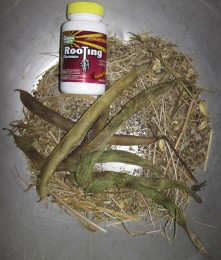
Bowl-O-Seeds. Rooting powder was used to help the seeds germinate, a tall task during these wintery days.
2. The vegetable seeds were all mixed together with rooting powder (only because I didn’t have any mycorizzae spore on hand). Life is good!, especially when I get to open dozens of seed packets that I prepared throughout last growing season. Round and round, mixed in a large stainless bowl, or bucket, and dusted with a little love (spore or rooting powder). Then I’ll carefully toss the seeds out onto a prepared planting bed — a dash here, a dash there, some over my right shoulder, some underhanded between my legs. Most importantly, I get to have fun being ridiculous. I get to plant way too many seeds. Yes, I work hard to collect seeds all year long so that I can have a Chia Pet garden. Too many plants that grow too much means I will eventually get to havest them, in whole or in part, and reap the green manure they are. I will be harvesting carbon — all that alive, green plant material is merely bottled up sunshine to be poured onto the compost pile. Sun >>> plants >>> photosynthesis >>> juicy packets of carbon >>> Tony’s compost >>> SOIL MAKING. And with that carbon-rich soil, we will grow more STUFF, whether it be flowers, food, or fodder. And we will live happily ever after.
The seeds I grew and collected and mixed together are cilantro, parsley, Queen Anne’s lace, bok choy, gopher plant, impatiens, fennel, round zuccini, calendula, “Primo” danelion, and chard. Store-bought seeds that also became part of the mix are broccoli, cauliflower, and lettuce. SOMETHING ought to grow!
3. The seeded bed, also with its garlic starts, was mulched with rice straw to keep critters away from the seeds and to keep the seeds moist for germination. The mulch will also help the seeds receive waterings and/or rain without being washed out of the planting bed. Perhaps too heavy a cover of straw to be left on the young sprouts. BUT, I will keep an eye on the bed and will thin off some of the straw in a week or two. I will be curious to see what plants actually do come up during these frosty nights and cool days. Nice to have some ground warm perculating upward toward the seeds from the hot manure below. Even if nothing were to germinate now, surely some seeds will germinate further down the year when the sun warms the soil and spring rains moisten it. How fun to wait and see.
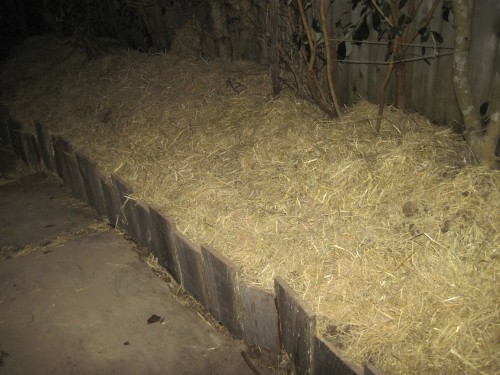
The seeds have been sown and the rice straw mulch is in place. A little water. A lot of waiting. Soon enough, though, a forest of food and flowers.
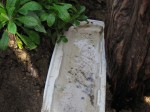
1. Installed an underground watering hole habitat, called Dano’s Great Newt Grotto.
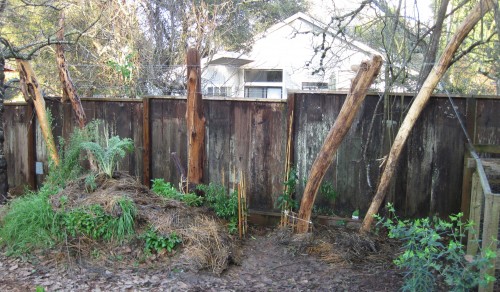
Trellis habitat, House Finch Hideaway. The subterranean habitat, Dano's Great Newt Habitat, was installed while the Center Pole posthole was being backfilled.
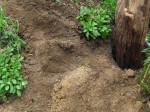
Center Post (2 posts) in ground, yet to be backfilled. The posts were dug in on the back side of Captain Cicada's Buried Treasure, a buried wood pile animal habitat. The adobe soil in the foreground is from the posthole digging and covers the small hill's topsoil.
1. The celestial heavens were so kind to me the other day. Dan and I were on our way to completing an awesome garden project — a 6-post two-tier trellis built to grow food and provide privacy. We had just lowered the Center Post (which is actually 2 posts; see House Finch Hideaway — Completed ) into its hole when the noontime lunch whistle blew. Dan was off to follow his stomach’s commands. Cool!, now I have some time to throw in a habitat up against the center posts before the area is backfilled. A quick search of material caches and I was back with a toilet tank top, a small piece of flagstone slate, two old kitchen tiles, a water-catching boulder, and a bucket lid. Habitat here we come!
Water. So often when building a habitat, I include a focus of making water, or at least moisture, available for garden critters. Perhaps I am so drawn to water because one of my strongest passions in building animal habitats is to increase amphibian populations in residential gardens. And amphibians LOVE, thrive, and do water well (pun accepted!). This habitat’s major water feature is a toilet tank top rescued from a dumpster. “Help, help, please help!”, I faintly heard coming from the bottom of a commercial renovation project’s 10-yard dumpster. So I took the beautiful uncracked enamel critter swimming pool home with me and vowed to incorporate it in a habitat. Alas, Toilet Tank Top is delivered to the soil and its critters while Dan is off at lunch. A little water in the upside down lid helps me install it level (to hold the most amount of water possible).
The enamel coated top side of the toilet tank lid seals the pottery and enables it to hold water. The underside of the lid, which is pictured holding water, will absorb some of that water because it is not enamel coated. But that’s okay — moisture-loving critters, like insects, snails, slugs, salamanders, frogs and toads, will seek out that cool dampness in the dryer months.
I stand on the upside down lid to press it into the adobe soil at the edge of the posthole and up against the Center Post. It sets in firmly and gives me confidence that it will hold at least some water, that is, stay level, for a long time.
Now to protect the top of the swimming pool to keep it from completely filling with soil. Some soil will likely backfill into the swimming pool, and that’s okay, but we would like some of the upside down toilet lid’s volume to be available for water. Completely sealed off would not be good either — the critters would think the pool is closed. “Oh man, we always come on the wrong day!” A small piece of flagstone slate and kitchen tiles are the strong, non-biodegradable materials I come up with to protect the habitat’s pool of water. Two kitchen tiles are used to add strength and to provide another crevice (between the tiles) that critters can take advantage of. Sure there’s a gap between the tiles and the slate but we’ll deal with that shortly. For now, we’re sitting pretty because the swimming pool was just upgraded to a grotto. How European! The subterranean pool, or grotto, will shelter and feed many a microbe and larger critter that had never dreamed of travelling to such places.
Now to cover the small gap between the tiles. And I just happen to have a bucket lid that will cover that gap. One good thing about the plastic lid is that it will last a zillion years. Sure, some people would cringe about burying plastic in the garden but I figure that the trade-offs here are worth it. If it never breaks down, then some critters will have shelter security. If it does break down, then we are doing our part to return this human-made atrocity to the soil. Hey, why get out of bed in the morning if your rationalization system is not intact?! And now back to the plastic bucket lid on top of the kitchen tiles and the flagstone slate. Yes!, the bucket lid turns out to more helpful than I thought it would be. Not only will it cover the gap, but also it is a coaster (like a table coaster protecting delicate wood) for the brittle tile and crackable slate. Now a good-sized rock, AKA boulder, can be stacked on top of the grotto, tiles, and slate.
Multi-tasker boulder will 1) keep the materials below it securely in place because of its heavy weight, 2) provide temperature modulation to the habitat, and 3) hold a smidgen of water in the small indentations on its top surface. That’s pretty much the bulk of the habitat, but now I want to take measures to protect this underground waterhole, this subterranean grotto. Because it’s underground, or hidden, foot traffic could easily kick it apart by accident. I grab a couple of fireplace logs and frame the exposed tile corner. That sits pretty but why leave things up to chance?
I take the extra time to secure the downhill side of a log with a hefty wooden stake pounded into the ground. The stake is surely very secure BUT I missed my mark. The stake is a couple of inches away from the fireplace log instead of snugly up against it. Once again, THE PROBLEM IS THE SOLUTION (a permaculture axium). In other words, there’s good to be found here so why not go with that? Lucky for me, I sometimes take my own advice. I snug the firewood log up against the post to expose a gap alongside the habitat. That gap, or couple of inches “off”, will now allow me to throw in some nutritious compost soil. There will be more good soil for the jasmine vine I will plant above this habitat.
Time to plant the jasmine vine that will grow up Center Post and create a thicket on the trellis. The grotto habitat is nearly complete except for planting and cosmetic issues. The jasmine vine’s roots will help secure the “hillside” of soil and help tie together the habitat’s elements. Perhaps those roots will find the grotto and drink its water — hard to say because the roots will not develop in the intended air cavity of the habitat. In the end, though, I vote that the jasmine will be a happy camper as a result of the grotto habitat. If nothing else, the poop factor will benefit the jasmine — there will be so much poop (that feeds the soil) from the snails and slugs that come to vacation at the grotto.
Compost soil is strewn over the habitat and surrounding area. The jasmine vine is wiggled into position next to the boulder and surrounded by as much compost soil as will stay on the little hill of Captain Cicada’s Buried Treasure. Forget-me-not plants that were moved to the side for protection are returned to the hill, above the habitat. Some bamboo stakes are pounded into the ground and strung together to make small fences to protect the area from foot traffic. Lastly, old straw mulch is used to keep the compost soil and plants in place. Also, the old straw mulch will keep the area moist and humus-rich as it breaks down. The decaying straw is a habitat unto itself!
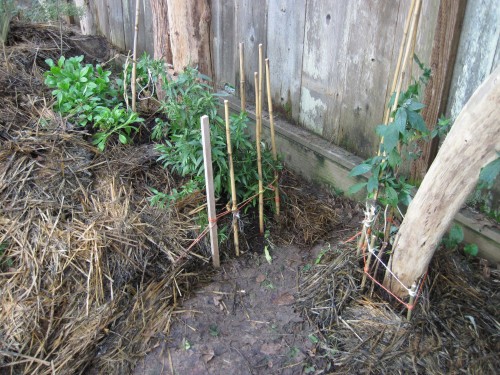
Dano's Great Newt Grotto habitat is buried under old straw mulch (left). Grape cuttings at a post's base for the trellis habitat, House Finch Hideaway.
What a great day! A habitat within a habitat day. Hard work and looking forward to my vacation. See you at The Grotto.
……………………………………………………. Tony
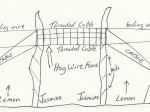
1. Installed posts for House Finch Hideaway.
1. A beloved neighbor of mine has very little privacy in her back yard and wants more. Her yard slopes up from the back fence, so her back neighbors have a straight-shot view of her patio sliding door and into the house. What a drag to have to draw the curtains for privacy. But, I want to see the garden! Solution: Create privacy at the fence. Then, even the garden becomes private.
I love trellises. Vertical growing allows stacked vegetation (Ex. = plants on the ground and above) or “stacked functions” [a permaculture term] (Ex. = a clear walkway below and plants above). We will use a trellis to create Beloved Neighbor’s privacy and support for fruit vines. Grape, kiwi, fig, and espaliered lemon all do well growing along trellis wire. However, because our first goal is to create privacy, evergreen plants become our first choice. Of those fruiting vines just mentioned, only the lemon is evergreen. And one drawback to evergreen lemon trees is their relatively slow growth when compared to fruiting vines. Pink Jasmine to the rescue — a fast growing evergreen vine with very fragrant flowers. The jasmine will become a suspended thicket very welcoming to nesting birds and the fragrant flowers will attract bees and hummingbirds during the early spring bloom.
My friend, Jim, an organic apple farmer, took me for a walk in the orchard last spring. He was excited to show me the perimeter fencing that he installed. Jim’s wire fence is a grape trellis, and a couple of thousand feet long. That’s a lot of grapes. He was particularly excited to show me how simple the hardware is. I was sold. Why just put up a fence when the same fence can support a crop? House Finch Hideaway is basically a vinyard fence a few more feet off the ground and not very long. The entire trellis will be 2 end posts with 2 center posts between them.
Yes!, I get to sink driftwood into the ground. I just happen to have a few good-sized driftwood poles left over from last year’s driftwood collecting. The four poles I’ll be using are all well over 10 feet long. They are long enough to secure 5-6 feet in the ground and still reach above the fenceline a few feet. My custom-made posthole digger tool (electric conduit fastened to digging clams) is long enough to do the job and save my back from breaking. And wala!, the first post, the Left end post, is in. I chose to sink that post first because placement next to the cherry tree is more critical than with other elements in the yard. The post was up-ended, in other words, the heavy trunk end was flipped up into the air and the thinner end of the pole was sent into the ground. Art! We want creatures in the garden and what better way to do that than to jog the imagination with tree trunks in the air.
The oddly angled posts present some challenges for this linear wire trellis. Sinking the driftwood posts for allignment of all four posts is part guesswork and part skill. I have worked with driftwood for a long time and can anticipate how pieces will lay, most of the time. Fortuneately for me, I did goof up here by the time I got to the center posts. But that’s part of my skill — to take advantage of goof ups. For instance, I THOUGHT I wanted the center posts perfectly vertical, like a respectable fence ought to be. BUT, I wasn’t thinking clearly and dug the center holes vertically. Well, duh, the two center posts are not straight. In the end, after some trial and error by my lowering them into both holes only to retreive them and switch their position, the posts told me where they belong. And what beautiful gracefulness they are in, with the strength of the trellis magnified by their self-directed position. Specifically, the center posts are also openning outward, as are the end posts, which will better stretch the fruit-laden wires of the trellis. There will be less sagging in the middle of the trellis because of the great tension created by the outward-facing posts. The wood talks!
All four posts have been left loose in their holes, in other words, soil has not been backfilled to secure their position. The posts might want to twist and turn a bit when the wire fenceline is tightened — no sense in counteracting that movement. Then, when the wire tension is appropriate, and the posts have fallen into resting position, the postholes will be backfilled with planting mix and vine starts. What happy plants they will be, with their roots sucking water from the hugh wood posts.
Installing earth anchors for the two end posts is next. Securing the end posts to the ground will help keep them from breaking under the heavy weight of the vines, fruit, wire and center posts.
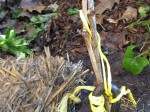
Grape vine cuttings planted with Left earth anchor. Note the highly visible yellow cord to warn passersby.
I don’t want to lose sight of how deep the anchors are so I use a crude stick measurement for the before and after depth of the anchors. A crowbar in the anchor’s eye helps drill the other end’s screw into the soil. Well, that anchor is pretty far down there but I will fill in the hole with heavy adobe clay to increase the weight on the anchor — would be a drag if the vine and fruit loaded trellis and poles were to heave out the anchor some day. Keeping the adobe soaked in the hole will help it pack and maximize it’s volume and weight as it settles.
With both earth anchors in place, now it’s time to wire the end posts to the anchors. 13 gauge galvanized vinyard wire will be secured by Gripple fasteners; see www.gripple.com for how Gripple’s line of agricultural hardware is used.
The endposts are secured with wires angling down to the ground at 45 degrees (90 degrees to the slanting posts). Yet to be done, the horizontal fruit-/vine-bearing wires will be strung between all four posts.
Today I got as far as wiring in the end posts. The horizontal wires will come another day. Stay posted, pun intended.
Tony